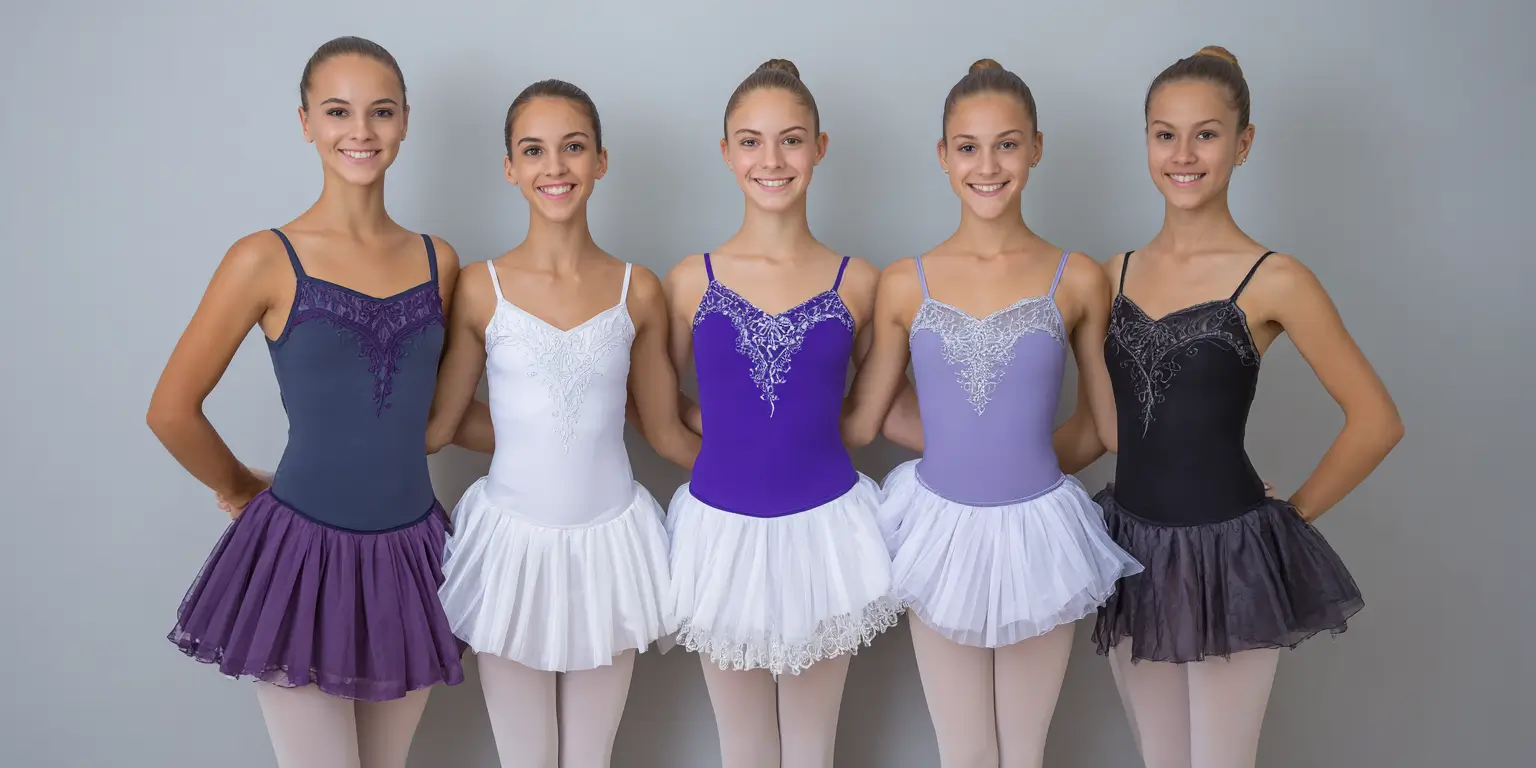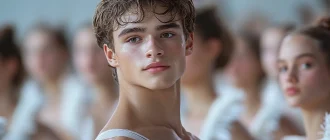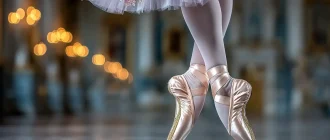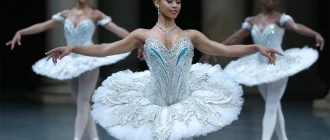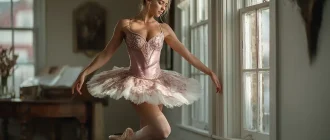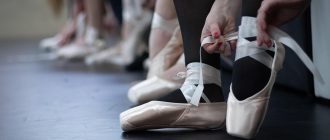Ever wonder why ballet tights are worn over a leotard? This common practice in ballet has deep roots in tradition and practicality. In this article, we examine the reasons behind this choice, including enhanced mobility, improved temperature regulation, and rapid costume changes, as well as the aesthetic and historical considerations.
Key Takeaways
- Ballet tights over leotards enhance mobility, provide better temperature regulation, and facilitate quick costume changes for dancers.
- The combination of tights and leotards creates a polished, uniform appearance that accentuates a dancer’s form and grace on stage.
- Proper fit and wearing techniques for tights and leotards are crucial for achieving comfort and optimal performance, as well as avoiding common mistakes that can hinder smooth movement and presentation.
Ballet’s Tights Tradition Podcast
Historical Origins of Ballet Attire
Ballet’s origins trace back to the grand courts of Italy and France, where it began as a blend of acrobatics and folk dance with an aristocratic flair. The first professional ballet company, established at the Paris Opera in 1713, marked the beginning of ballet as we know it today, allowing dancers to train rigorously and refine their art. Initially, ballet dancers wore elaborate everyday clothing, which, while visually stunning, proved impractical for dance due to its restrictive nature.
As women began participating in public ballet performances in France around 1681, more suitable dancewear became necessary. This necessity led to the invention of the leotard and tights, now staples in ballet attire. The late 18th-century introduction of tights revolutionized ballet, freeing dancers from the constraints of heavy costumes and enabling more complex movements and greater athleticism.
The evolution of ballet attire, particularly the adoption of tights, significantly expanded the boundaries of what was possible in dance. Ballet leotards and tights provided the necessary support and flexibility, contributing to the elegant silhouette that is synonymous with ballet today. For male dancers, the dance belt became an essential part of the uniform, providing proper support and ensuring modesty by eliminating visible lines and creating a uniform bulge.
This evolution highlights how appropriate attire enhances a dancer’s performance while preserving the tradition and elegance of ballet.
Practical Reasons for Wearing Tights Over a Leotard
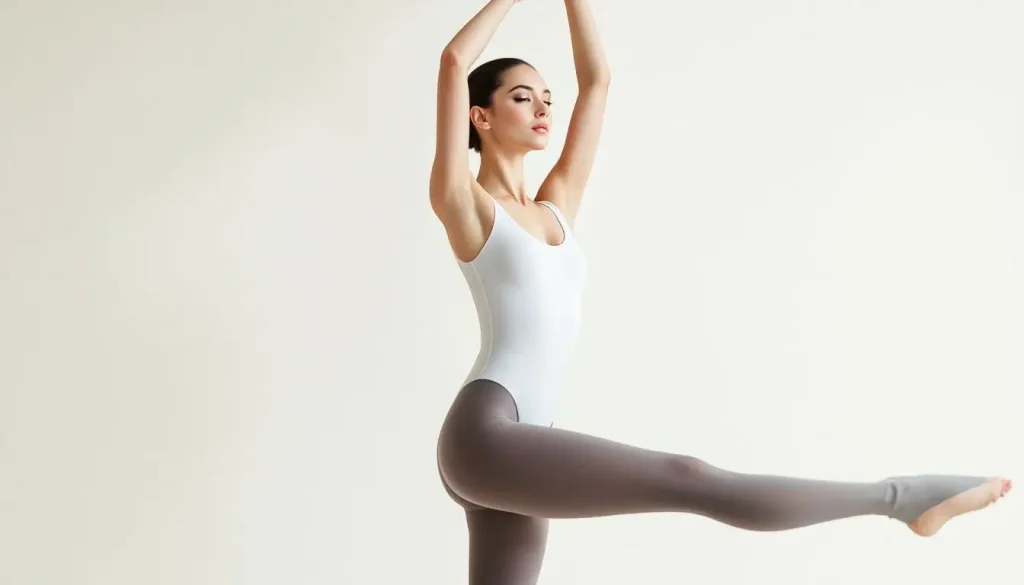
Wearing ballet tights over leotards serves practical purposes beyond tradition, enhancing a dancer’s performance. This setup provides additional support during rigorous movements, reduces friction, and improves freedom of movement.
Pointe shoes, along with tights and leotards, support dancers during performances, ensuring they can perform on pointe with stability and comfort.
It also aids in temperature regulation and quick costume changes, proving invaluable for dancers.
Enhanced Mobility
Mobility is paramount in ballet, where every movement must be executed with precision and grace. Tights worn over a leotard enhance mobility by reducing friction between fabric and skin. This reduction in friction enables dancers to perform complex movements with greater ease and fluidity, which is crucial for both practice and performance.
Conversely, wearing tights under a leotard can lead to discomfort and restricted movement, which can adversely affect a dancer’s performance. Properly sizing leotards and tights is crucial, as ill-fitting attire hinders free movement.
Tights and leotards together provide support and enhance a dancer’s stage silhouette.
Temperature Regulation
Temperature regulation is another key reason for wearing tights over leotards. Ballet tights help retain body heat, thereby maintaining muscle flexibility and preventing stiffness, especially in cold weather. During performances and rehearsals, maintaining an optimal body temperature ensures that dancers can perform at their best without the risk of injury.
This combination of leg warmers is particularly effective in cool environments, where heat retention is crucial for performance. This layered approach helps dancers stay warm and comfortable, allowing them to focus on their movements and technique rather than being distracted by the very cold weather.
Quick Changes
A practical reason for wearing tights over leotards is the convenience during quick costume changes. In ballet’s fast-paced environment, dancers often need to change outfits rapidly between scenes. Tights worn over the leotard simplify this process, enabling quicker changes without the need to remove multiple layers.
This practice is particularly beneficial during performances with multiple acts or for dancers participating in back-to-back rehearsals. Quick costume changes ensure performances run smoothly, minimizing downtime and maintaining show flow.
Aesthetic Considerations
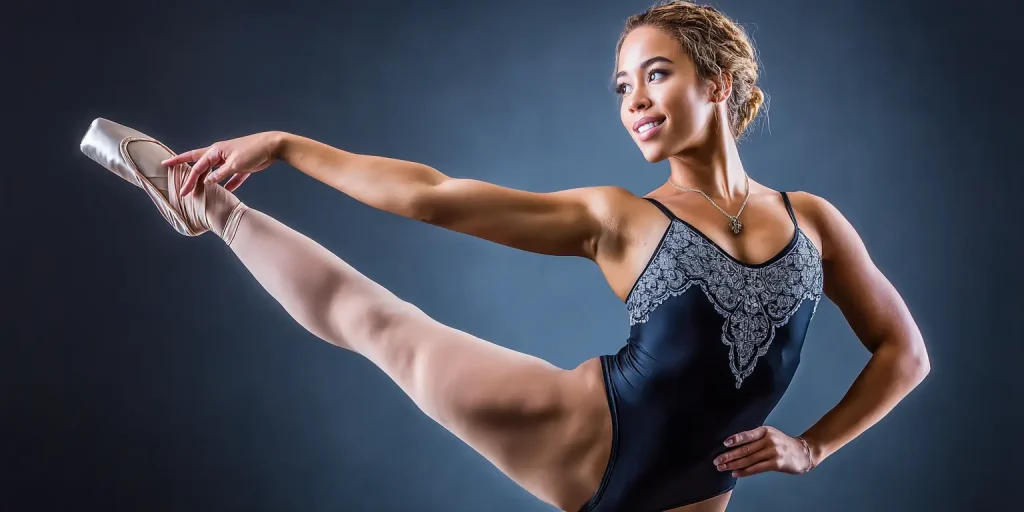
Beyond practicality, this attire choice has a significant impact on the aesthetic appeal of a performance. It promotes a polished, cohesive appearance, aligning with ballet’s tradition of uniformity and elegance.
The combination of tights and leotards contributes to a visually seamless and elegant presentation, enhancing the overall experience for both dancers and the audience.
Clean Lines and Uniformity
Creating clean lines and maintaining uniformity in appearance are critical in ballet. Tights over leotards create a streamlined look, emphasizing the dancer’s form and movements. To achieve this, many dancers wear black tights, which contribute to a simplified look and visual impact, aligning with costume requirements and enhancing the overall performance.
Tight color choices can enhance visual impact, with styles and shades of pink accentuating leg movements and adding to the elegance of performance. Integrating pink tights into ballet attire highlights leg movements and contributes to ballet’s classic, timeless aesthetic.
Visual Impact
The visual presentation of a dancer is a crucial component of any ballet performance. This practice creates a polished, professional image, enhancing visual appeal. This practice helps to create clean lines and a uniform appearance on stage, which is essential for achieving an aesthetically pleasing presentation.
Ballet tights accentuate leg contours, showcasing muscular definition and elegance. This not only enhances the dancer’s legs but also reinforces the grace and artistry inherent in ballet performances.
Studio Dress Codes and Personal Preferences
Studio dress codes and personal preferences also play a significant role in why dancers wear tights over leotards. Many studios implement dress codes to maintain uniformity and professionalism.
For a cohesive look in dance attire, especially when the dance studio does not specify a color requirement, most dancers should opt to wear skin tone tights to match their skin tone and jazz shoes.
However, personal comfort and preferences can also influence this practice, with some dancers choosing to wear tights over leotards for added comfort and ease of movement.
Instructor Guidelines
Ballet studios often have strict dress codes designed to maintain a professional and uniform appearance among students. These guidelines can vary based on the age group and level of the class, with different requirements for younger students versus advanced dancers. In some studios, the dress code may specifically require wearing tights over leotards to achieve a more polished look.
Adhering to dress codes maintains tradition and fosters discipline and professionalism among dancers. These guidelines also boost confidence, ensuring dancers present themselves well.
Personal Comfort
Although dress codes are important, personal comfort is equally crucial. Many dancers prefer tights over leotards for the ease of feeling the back of only a leotard’s fabric directly against the skin. This preference can vary based on individual experiences and what feels best for each dancer during practice and performances.
Some dancers may initially feel uncomfortable with this setup, especially if they are unaccustomed to it. Properly fitting leotards, especially long-sleeve ones, are crucial to avoid discomfort and enhance the overall show floor experience.
The Importance of Ballet Tights for Ballet Dancers
Ballet tights are an indispensable part of a ballet dancer’s outfit, offering much more than just aesthetic appeal. These tights are meticulously designed to provide the necessary support and flexibility that dancers need to perform their intricate movements with precision and grace. Unlike regular tights, ballet tights are crafted to withstand the rigors of dance, ensuring that they move seamlessly with the dancer’s body.
One of the key roles of ballet tights is to enhance the dancer’s movements. The snug fit and stretchy material allow for a full range of motion, enabling dancers to execute complex steps and poses without any hindrance. This flexibility is crucial for maintaining the fluidity and elegance that ballet is known for.
In addition to their functional benefits, ballet tights also play a significant role in maintaining the dancer’s modesty. They cover the legs completely, preventing any embarrassing accidents and ensuring that the dancer feels confident and secure during performances. This is particularly important in a discipline where the focus is on the purity and precision of movement.
Moreover, ballet tights contribute to a uniform appearance among dancers, which is essential for group performances. The cohesive look created by matching dance tights helps to emphasize the synchronicity and harmony of the ensemble, enhancing the overall visual impact of the performance. Whether dancers wear pink tights, skin tone tights, or black and white tights together, the uniformity they provide is a cornerstone of ballet’s aesthetic tradition.
Different Styles of Ballet Tights
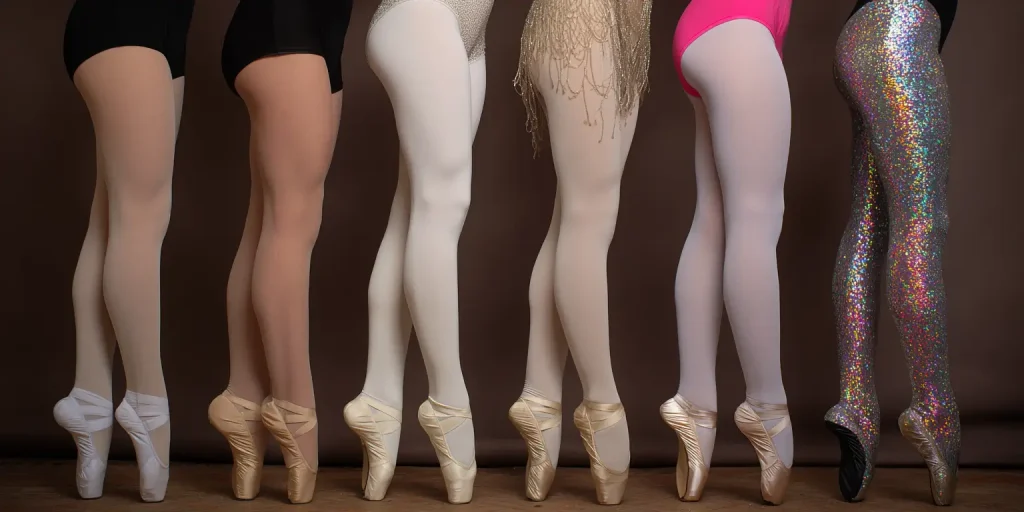
Ballet tights come in various styles, each offering unique benefits for different preferences and needs. Footed tights, common in classical dance lessons, provide a snug fit inside ballet shoes. These tights are thicker than regular tights, designed to withstand the demands of ballet and provide the necessary support and durability.
Footless tights, popular in modern dance, are also suitable for classical ballet based on dance parents ‘ and instructors’ preferences. Stirrup tights, leaving toe and heel uncovered, are favored in class and by experienced dancers for their versatility. Convertible tights offer easy switching between footed and footless styles.
Body tights, designed for experienced dancers, offer a snug fit that enhances performance with added support and compression. Made from durable materials like nylon, spandex, and cotton, these dance tights maintain leg appearance and support rigorous routines. Tights choice often depends on personal comfort and specific class or performance requirements.
How to Choose the Right Ballet Tights
Choosing the right ballet tights can be a daunting task, especially for those new to the world of ballet. However, with a few key considerations, you can find the perfect pair of convertible tights to complement your ballet outfit and enhance your performance.
- Consider the Color: Ballet tights come in a variety of colors, including the classic pink, white, black, nude, and tan/beige. The color you choose should match your dance shoes and costume. For instance, pink tights are often preferred for their traditional look, while black tights can be a striking choice for contemporary performances.
- Consider the Material: The material of the tights is crucial for both comfort and durability. Ballet tights are typically made from nylon, spandex, or a blend of both. Nylon offers durability and a smooth finish, while spandex provides the necessary stretch and flexibility. Some tights also incorporate cotton for added softness.
- Check the Thickness: Ballet tights vary in thickness, from sheer to opaque. Thicker tights offer more support and compression, which can be beneficial for muscle recovery and performance. Thinner tights, on the other hand, provide a lighter feel and are often preferred for their breathability.
- Consider the Style: Ballet tights come in different styles, including footed, footless, and convertible. Footed tights are the most traditional option, providing a seamless look when paired with ballet shoes. Footless tights are ideal for modern dance styles, while convertible tights offer the versatility of switching between footed and footless as needed.
- Read Reviews: Before making a purchase, it’s helpful to read reviews from other dancers. Reviews can offer valuable insights into the quality, fit, and durability of the tights, enabling you to make an informed decision.
By considering these factors, you can choose ballet tights that not only complement your ballet outfit but also enhance your performance and comfort.
How to Properly Wear Ballet Tights Over a Leotard
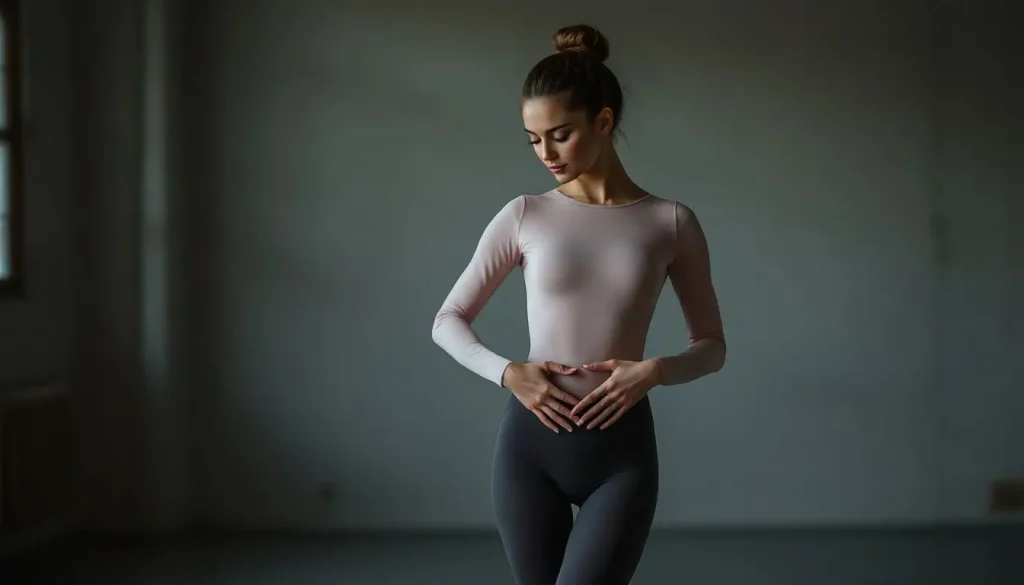
Wearing ballet tights over leotards properly ensures comfort, support, and a polished appearance. Many are unaware of the proper way to wear these essential components, leading to discomfort and reduced performance.
Correctly wearing pants in a ballet outfit, including a leotard and tights, is essential for any ballet dancer.
Step-by-Step Guide
For a perfect fit, ballet tights should be snug along the waist and leg with no sagging. Start putting on ballet tights by stepping into them and carefully pulling them up to avoid stretching or ripping. This method ensures a snug and comfortable fit that supports the dancer’s movements.
Choosing the right size, shape, and style is crucial for both comfort and performance. Dancers should practice wearing their leotards and tights to become accustomed to the same shape and fit, which enhances their stage performance. The leotard should cover the stomach, ensuring a neat appearance under the tights.
Wearing a ballet leotard and tights correctly ensures dancers look great while staying comfortable and supported.
Common Mistakes to Avoid
A common mistake is selecting the wrong size for leotards and tights, which can lead to discomfort and restricted movement. A correct fit is essential for ease of movement and optimal performance quality.
Another mistake is wearing the leotard incorrectly, which causes the tights to sag and negatively impacts the appearance. Avoiding these errors ensures dancers present themselves well and perform at their highest level.
Proper attire is not just about aesthetics; it’s also about functionality and comfort.
Caring for Your Ballet Tights
Proper care for your ballet tights is essential to maintain their quality and extend their lifespan. Ballet tights are an investment in your dance wardrobe, and with the right care, they can continue to provide the support and appearance you need for your performances.
- Wash Them Gently: Ballet tights should be hand-washed in cool water with a mild soap. Avoid using harsh detergents or machine washing, as these can damage the delicate material. Gently swish the tights in the water and rinse thoroughly to remove any soap residue.
- Dry Them Flat: After washing, lay your ballet tights flat to dry. Avoid hanging them up, as this can cause stretching or sagging. Place them on a clean, dry towel and roll the towel to remove excess water, then lay them flat in a shaded area away from direct sunlight.
- Store Them Properly: Store your ballet tights in a cool, dry place, away from direct sunlight. Avoid folding or creasing them, as this can cause wrinkles or damage to the material. Instead, roll them gently and place them in a drawer or a dedicated storage bag.
- Replace Them Regularly: Ballet tights have a limited lifespan and should be replaced regularly. Check your tights for signs of wear and tear, such as holes, runs, or sagging. If you notice any of these issues, it’s time to invest in a new pair to ensure you maintain a polished and professional appearance.
By following these care tips, you can keep your ballet tights in excellent condition, ensuring they continue to support your movements and enhance your performance. Properly maintained ballet tights are not only more comfortable but also contribute to a more polished and professional look on stage.
Summary
Wearing ballet tights over leotards is a practice rooted in history, practicality, and aesthetics. From enhancing mobility and temperature regulation to facilitating quick changes and creating a polished appearance, this attire choice is essential for ballet dancers. Understanding the various styles of tights and how to wear them properly can significantly impact a dancer’s performance and comfort. By adhering to studio dress codes and considering personal preferences, dancers can ensure they are always at their best.
| Key Reason | Tradition / Culture | Practical Pay-off |
|---|---|---|
| “Pro look” vs “student look” | In many academies, students must wear tights under the leo; company dancers started flipping the order as an informal rite of passage that signals I’m out of school now. | Let professionals individualize class wear without breaking the line of authority in school settings. |
| Faster costume & restroom breaks | Backstage quick-change lore dating to mid-20th-century touring companies: outer tights could be peeled off in seconds between numbers. | Saves precious seconds during show changes and makes bathroom trips easier during long rehearsal days. |
| Secure coverage in a partnership | Partner work exposed a problem: leotards can ride up when lifted; placing tights on top became a discreet fix theaters adopted in the 1970s. | Extra friction keeps the leo seat in place, sparing dancers awkward adjustments mid-lift. |
| Cleaner, longer leg line | Teachers noticed that an unbroken color from hip to toe in photographs and on stage photographs reads better; “tights-over” became the studio aesthetic. | Visually elongates the legs and gives faculty a clear view of alignment without a harsh hip seam. |
| Layering & warmth control | Pros often layer warm-ups and rollable convertible tights; wearing them outermost means they can roll them down to footless or strip off layers as the body heats. | Quick temperature regulation, easy toe access for tape/blisters, and adaptable for multiple dance styles in one day. |
Frequently Asked Questions
Why do ballet dancers wear tights over their leotards?
Ballet dancers wear tights over their leotards to enhance mobility and maintain a polished look. It also aids in temperature regulation and facilitates costume changes more quickly and easily.
What are the different styles of ballet tights?
Ballet tights come in various styles, including footed, footless, convertible, and stirrup, each catering to different needs and preferences. So, you can choose the one that best fits your dancing style!
How do I properly wear ballet tights over a leotard?
To wear ballet tights over a leotard correctly, make sure the tights fit snugly at the waist and legs, and step into them carefully to avoid any damage. Your leotard or regular tights should cover your shoulders and stomach for a clean look.
What should I avoid when wearing ballet tights over a leotard?
To maintain a polished look, avoid wearing tights, trousers, and leotards that are the wrong size, as this can cause discomfort and sagging. Ensure everything fits well for a smooth and confident performance!
Why is temperature regulation important in ballet?
Temperature regulation is important in ballet because it keeps your muscles flexible and prevents stiffness, allowing you to dance at your best. Staying warm with clothing like tights can make a significant difference in your performance.
Why do dancers sometimes wear tights over their leotard instead of under?
Wearing tights over the leotard can create a longer-looking leg line, protect the leotard fabric from wear and tear, and provide easier restroom access during cold-weather classes when layers are involved.
Does wearing tights over a leotard affect compression benefits?
Yes—tights worn under the leotard provide better compression directly on the muscles, improving circulation; layering them over may slightly reduce that effect.
Are ballet tights different from regular fashion tights?
Absolutely. Ballet tights have flat, soft waistbands; thicker denier for opacity and durability; and may come in footed, footless, or convertible styles—unlike thin, sheer fashion hosiery.
What materials are ballet tights made from?
They’re typically a blend of nylon and spandex (sometimes cotton blends), chosen for strength, stretch, and breathability under stage lights.
Why is there a cotton gusset in women’s ballet tights?
The gusset adds hygiene and comfort, serving as underwear so dancers don’t need separate undergarments beneath their tights.
Are men’s ballet tights different from women’s?
Yes—men’s tights are thicker and lack a cotton gusset; they’re designed to be worn without undergarments (though a dance belt is essential).
How should ballet tights fit?
Tights should be snug all over—no sagging at the crotch or knees and smooth across the waist—ensuring clean lines and no interference with movement.
What does “denier” mean, and why does it matter?
Denier indicates fabric thickness—ballet tights typically 60–70 denier or higher for opacity and durability, especially on stage.
What’s the difference between matte and shimmer tights?
Matte tights offer a flat finish, ideal for classic studio looks, while shimmer (gloss) tights reflect light, often chosen for performances to enhance the visual effect.
Why do some dancers wear two pairs of tights?
Dual layers help prevent transparency under stage lights, provide added warmth, and offer backup in case of snagging or tearing mid-performance.
How do you prevent tights from slipping during class?
Please choose the right size, pull them up fully to the waist, and ensure a snug fit; the leotard holds women’s tights, but men may add elastic bands.
Are convertible tights worth it?
Yes—they feature a foot opening so dancers can quickly switch between footed and footless without changing tights—ideal for barre vs. center work.
How do you care for ballet tights to make them last?
Hand wash or use a lingerie bag in delicate, cold water, and line dry. Despite care, most dancers replace their tights every few months due to wear.
Can you wear tights without a leotard?
In informal or warm classes, some dancers opt to wear tights with a fitted top, but leotards remain essential where alignment and uniformity are emphasized.
Why are skin-tone (flesh-colored) tights now more common?
To support diversity, many dance companies and schools offer flesh-toned tights that match dancers of various ethnicities, moving beyond traditional pink hues.
What advantages do tights offer during performances?
Tights smooth out imperfections (like bruises or hair), improve hygiene by acting as a barrier from floor contact, and maintain modesty under stage lighting.
Do tights help with muscle support and injury prevention?
Yes, light compression stabilizes muscle tissue, reduces vibration during jumps, and supports circulation to help prevent fatigue and injury.
Should beginners invest in high-end ballet tights?
Not necessarily—basic performance-grade tights offer adequate stretch and durability for beginners; higher-end materials are more valuable for advanced training and stage work.
Can you dye white ballet tights?
Yes—some dancers dye white tights with fabric dyes (like Rit) to match skin tone or costume requirements, especially for men wearing white stage costumes.
Is there a dress code for tights and leotards in class?
Many studios expect women to wear pink tights and black or pink leotards, and men to wear black or white leotards with tights—these conventions ensure uniformity and clarity of line.
Do tights help you feel your body better in space?
Yes—wearing tight-fitting garments like leotards and tights helps dancers sense their limbs and alignment in space, improving proprioception and movement quality.

